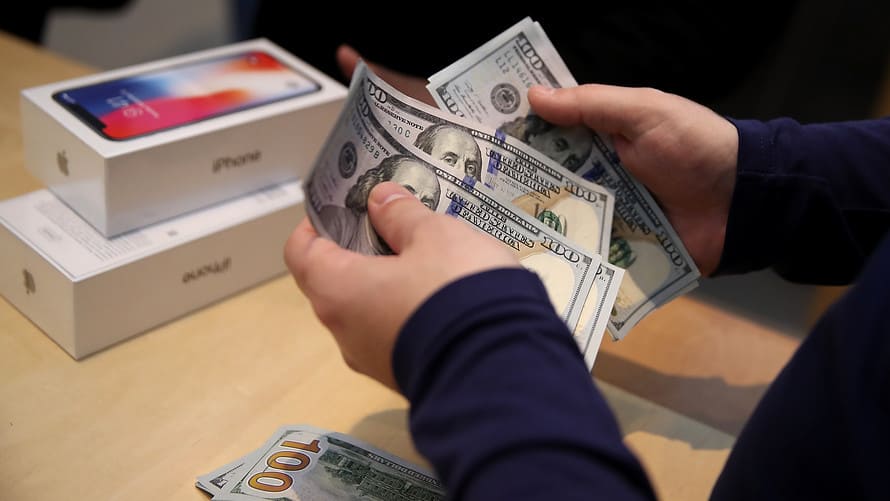
IPhone unit sales fell short in the last quarter, but Apple Inc. thinks investors should look beyond that stumble. Analysts, though, aren’t totally convinced.
In its earnings report late Thursday, Apple AAPL, -0.26% delivered better-than-expected, record sales of $88.3 billion and net income of slightly over $20 billion for the fiscal first quarter. But unit sales of iPhones missed — 77.3 million sold in the holiday quarter, versus forecasts for 80 million — and actually declined, relative to a year before.
GBH Insights analyst Daniel Ives called this a “ripping the Band-Aid off” report for Apple, as the company had to face questions regarding weaker-than-expected iPhone X demand and its impact on the financials.
Given that the iPhone X was expected to drive a “supercycle” of device upgrades, the financial update wasn’t what investors were looking for. Plus, Apple delivered a lower forecast for the March quarter than analysts had been expecting.
Still, investors were cheered by news the company plans to spend more than $160 million of its mega cash pile, with the bulk of that likely to go right back to shareholders.
That said, the report prompted a downgrade from analysts at KeyBanc Capital Markets, who cut Apple to sector weight from overweight Friday. They said a big cash return should help support the stock, but they still see little upside for the tech giant’s shares.
“While we hesitate to downgrade the shares of a company with as much dry powder as AAPL, the secular pressures and soft profit outlook overwhelm the potential for cash return, in our view,” said the team of analysts, led by Andy Hargreaves, in a note to clients.
Weaker iPhone sell-through in quarter and softer-than-expected second-quarter guidance, “reinforces our view of a saturated market with a limited inelastic base,” Hargreaves said, noting Apple had missed its own forecasts on gross margin.
In addition, KeyBanc’s analysts expect Chief Executive Officer Tim Cook and co. will take a “more modest approach” over giving back that big cash pile. They believe the tech giant doesn’t want to signal a lack of growth, or increase interest-rate sensitivity around shares, by spending too much cash.
Bernstein analyst Toni Sacconaghi also cut his rating — from outperform to perform — citing his expectations for a “weak” cycle like the one Apple experienced with the iPhone 6S, which led to a period of stock underperformance.
“The stock is trading at the midpoint of its recent historical valuation ranges, and we believe risk reward is coming more into balance, particularly since it is unclear what catalysts might exist for the shares in the near-to-medium term,” Sacconaghi added.
X marks the spot
The iPhone X was center stage in the runup to earnings, on concerns the company had cut production on its latest and most expensive phone due to weak demand. Some were anticipating trouble due to disclosures in recent financial results from chipmakers such as Qualcomm Inc. QCOM, -1.09% , which said a big customer had pared orders more sharply than expected.
In the end, demand did appear weak, but the question is how much that matters in future. Apple was able to make up for lower-than-expected iPhone unit sales in a number of ways: Its services business is booming, for example, and the average price for the iPhones that it did sell was high.
That resonated with RBC Capital Markets, whose analysts stuck to an outperform rating and raised their price target slightly to $205 from $200 per share.
Apple is showing that sustainable revenue and earnings-per-share upside can be driven by more than just iPhone units, given its “impressive” growth in services, Watch and AirPod sales, for example, noted a team of analysts led by Amit Daryanani.
That Apple was able to beat revenue and earnings estimates while iPhone unit sales fell short seemed to initially impress investors, who sent shares 3% higher late Thursday. The stock is now down 3.4% in Friday trading.
In response to an analyst’s earnings-call question on whether Apple was trying to get investors to focus on the company’s ability to monetize existing iPhone users through services and additional products, rather than on unit sales, CEO Tim Cook said: “I have long believed that a 90-day clock on unit sales is a very surface way to view Apple.”
Long-term prospects
Nonetheless, the March outlook — and what it said about the company’s long-term prospects — remained a key issue for some analysts following the results.
GBH Insights analyst Ives still places a heavy emphasis on iPhone sales, but he’s looking beyond just March.
“Seeing the forest through the trees, we estimate Apple has roughly 350 million iPhones that are in the window of opportunity to upgrade over the next 12 to 18 months,” he wrote. “Now it’s about which model and price point ‘strike a chord’ for these customers to ultimately upgrade, as the iPhone X demand has softened since reaching a supply/balance level in late December.”
Ives believes high average selling prices for phones, as well as a resurgent China business, can help the company “navigate near-term headwinds.” He rates the stock as highly attractive and has a $205 price target on shares.
IPhone buyers paid an average of more than $796 in Apple’s fiscal first quarter, marking the first time that average selling price has topped $700. Analysts had been expecting that ASP to come in at $756, according to FactSet.
Earlier this week, BMO Capital analyst Tim Long cut Apple to sector weight from overweight, on the view the company may have hit a wall on raising iPhone prices.
“We estimate that about 30% of iPhones will be priced at over $900 this year, but we do not expect this figure to go any higher, particularly as only 12% of smartphones globally sell for over $600,” says Long.

